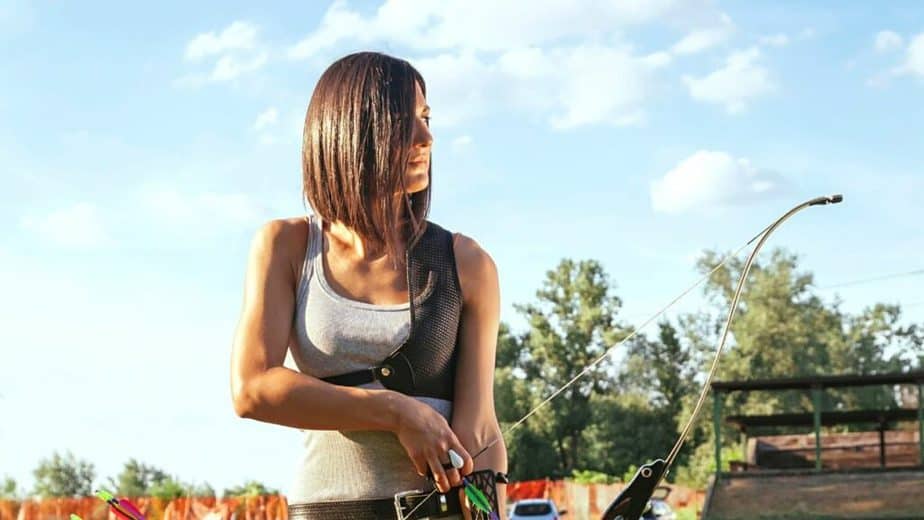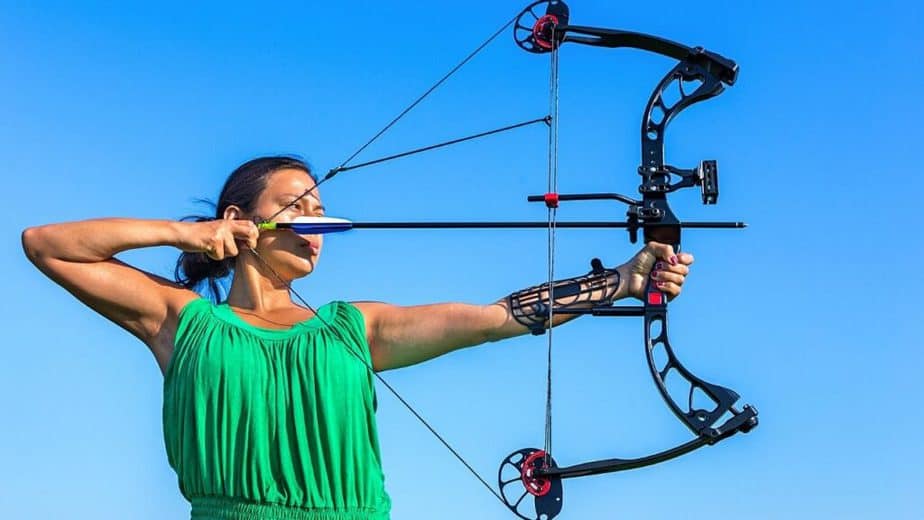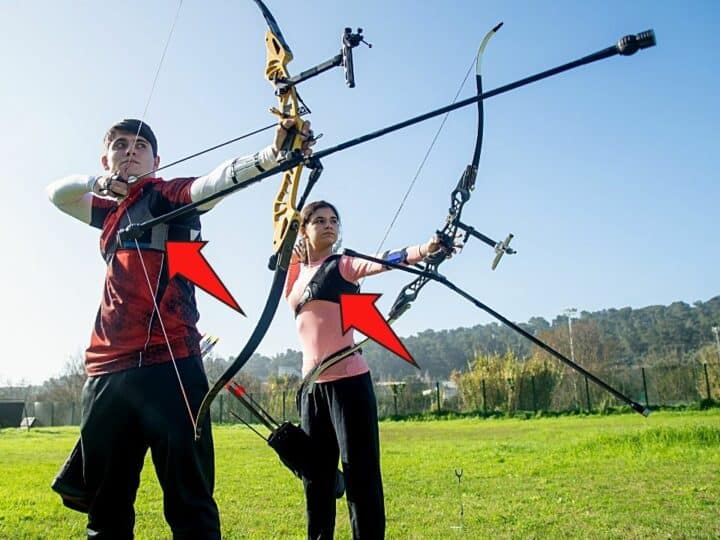One of the more amusing responses I’ve overheard in reply to the question, “Why would I need a chest guard?” is, “Well, it doesn’t hurt to get one.”
I don’t know if the speaker really was trying to be droll or not, but I couldn’t help but smile at the pun, intended or not.
Many beginner archers have been shocked to uncover a painful little secret about archery, an unpleasant surprise no one could suspect by just watching archers shoot their bolts.
Indeed, some archers don’t wear chest guards; in fact, many don’t.
As an archer gets better at the art, she (I use the female pronoun in this article because women are more concerned with its content) might become proficient enough not to need to wear chest protection.
Archery was also among the few sports that allowed women’s participation. One prime example is the Olympics in 1904 where women were competing for the first time according to World Archery.
Still, that doesn’t explain why archers wear chest guards in the first place, which I discuss below.
Table of Contents
Why Do Archers Wear Chest Guards?
Archers –mostly female archers – wear chest guards because female anatomy makes it more likely that the bowstring will impact the chest or clip the cloth of their tunic. Archers of either sex who practice archery for several hours a day may also wear a chest guard to defend against soreness.
The Sort of Archer Who Should Wear a Chest Guard
There may be a polite way of saying it, and perhaps even a politically correct one too, but it is a harsh truth that archers who need to wear a chest guard are those who have a well-endowed chest.
Although rising obesity rates and estrogen levels in American men mean moobs are quickly becoming as pervasive in archery as boobs, it is still the female form that is most often impacted by upper body tissue when shooting a bow and arrow.

When an archer releases a drawn bowstring, the bowstring goes from standstill to high speed in mere milliseconds, with a maximal amount of energy at its disposal.
In this phase, if the bowstring should hit an object, plenty of that energy would be transferred into the object, which is precisely what happens if a part of the human anatomy is in the way.
The resulting impact packs quite a smack, enough to dissuade a recipient from treating it as an inconvenient tickle – it’s not; it’s far more painful than that.
Over the decades since women’s archery has become a serious and widespread sport, it has therefore become necessary to find an acceptable and non-invasive method of preventing bowstrings from slamming into chests (see the FAQs section below for a harrowing suggested alternative).
Tissue Isn’t the Only Issue that Chest Guards Address
Perhaps the most pressing problem is the pain caused by an unruly bowstring, but there is yet another, and that is, apparel can also get in the way of the bowstring’s path, variously causing damage to self, bow, clothes, or perhaps making the archer miss her target.

Again, though, women have the worst of it because their body shape is such that clothing becomes more of an issue than compared to men.
How Chest Guards Work
Chest guards are handed, meaning it matters which is the archer’s dominant hand, right or left. A righthanded chest guard won’t work for a lefthanded archer, nor vice versa.
Paradoxically, what people refer to as a righthanded chest guard is actually slung over the left shoulder, from which you can guess that what people call a lefthanded chest guard is slung over the right shoulder.
In action, the chest guard “flattens” the wearer’s chest, allowing her to deliver a smoother shot. For this reason, the slicker the material from which the chest guard is made, the better.
However, since the bowstring often scrapes across the chest guard, the guard’s surface eventually becomes worn and rough.
A worn-out chest guard has lost a lot of its usefulness, so its owner needs to replace it as soon as possible, especially if she is due to take part in an upcoming competition.
I can attest from bitter experience that the niggle in the back of your mind triggered by a subpar chest guard is incredibly distracting.
One part of your head (the sensible part) might say, “Don’t worry about this, it’s not that important,” but unfortunately, the other pessimistic part of your head will say, “We’re doomed, it’s all over, this flipping chest guard is throwing off all my shots!”
Ways to Avoid Having to Wear a Chest Guard
The longer the bow is drawn, the farther the bowstring has to travel across the chest.
Therefore, one solution to the problem of a stinging or snagging bowstring is to use a shorter draw.
That’s all very well said and done, but of course, using a shorter draw dramatically lowers the amount of power that the archer can feed into the shot.
This reduces range, and the longer the distance to the target, the more this strategy reduces accuracy since the shooter has to mentally account for a more dramatically parabolic flight path than with a speedier arrow.
Another strategy that archers can employ to avoid wearing a chest guard is to use a compound bow because compound bows are drawn at an angle that means there is no realistic possibility of having the bowstring ever scrape across the shooter’s chest.

Quick Aside: There are Different Terms for ‘Chest Guard’
The commonest term is ‘chest guard,’ with a space.
Less common but still making many appearances in the literature about archery is ‘chestguard’ without a space. However, my spellchecker doesn’t like this form at all.
‘Plastron’ refers to the same protective gear but is hardly ever used. As a word, ‘plastron’ comes to us from Latin via French and means ‘breastplate.’
There is something to be noted in that plastron also refers to a part of the bony structure of a turtle’s shell, the shape of which is clearly breastplate-like.

Frequently Asked Questions about Why Archers Wear Chest Guards
So do all women wear chest guards?
Anyone with the proper body structure and appropriate technique doesn’t have to wear chest protection. The proper body structure is a flat chest, and the appropriate technique is a short draw. With these two attributes combined, the likelihood of being stung by the bowstring is highly reduced.
Did medieval archers use chest guards?
Medieval archers did not use chest guards. There were 3 pieces of protection a medieval archer would wear, and these were a thumb ring (protecting the thumb holding the bowstring), a finger tab (protecting the fingers drawing the bowstring), and a bracer strap (worn on the arm holding the bow).
Did Amazons remove a breast rather than wear a chest guard?
Amazons are from Greek mythology – such a tribe is unlikely to have ever existed. However, if they did, it is to be hoped that no one would have had to undergo such a horrific practice in an age before anesthesia, sterile surgical tools, or antibiotics.
Afterword: Why Do Archers Wear Chest Guards?
Women blessed with boobs and men cursed with moobs are pretty much in the same boat when it comes to finding a way to prevent their blessing or curse from interfering with their archery.
So archers of either sex who wear loose clothing. The archers who will benefit from this particular protective gear must not use a compound bow or have a draw that brings the bowstring across their body.

